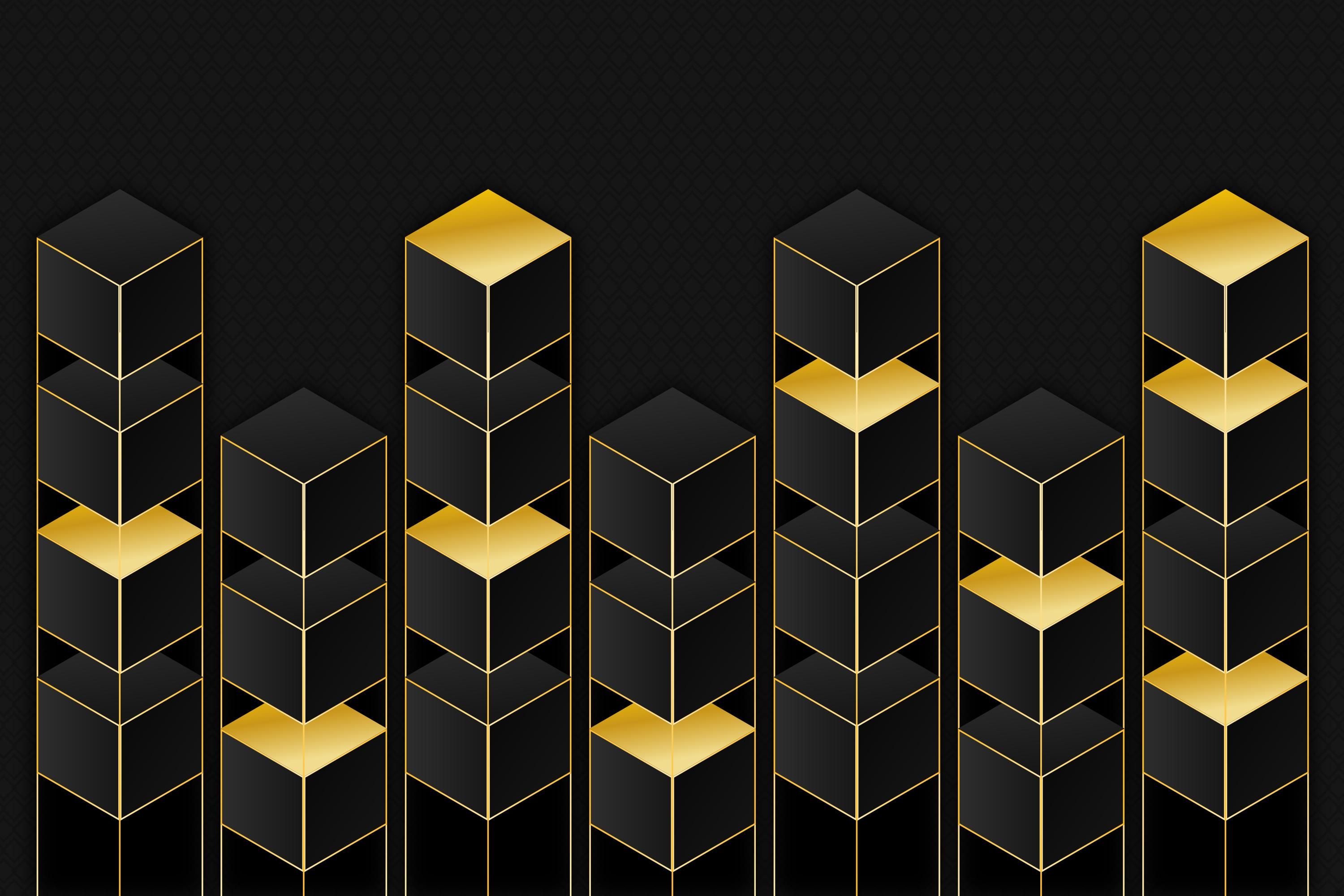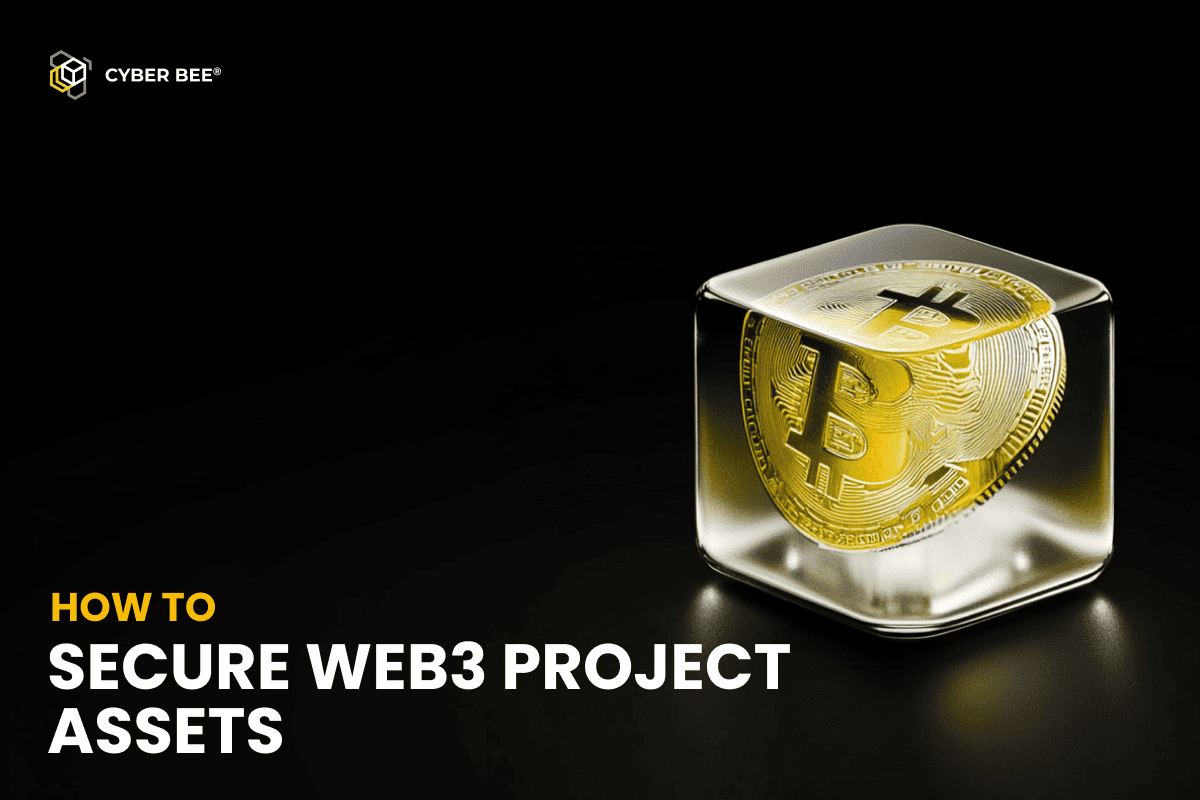Introduction: Unveiling the Power of Web3
Fresh off the heels of a whirlwind experience at Germany’s premier Web3 event, Conf3rence, the Cyber Bee team is buzzing with excitement! The energy and innovation on display were truly inspiring, solidifying our belief in the transformative power of blockchain and Web3 technology. Conf3rence served as a powerful reminder of the collaborative spirit driving Web3 forward. It’s through knowledge sharing and continuous learning that this revolutionary technology can reach its full potential.
That’s why we’re thrilled to present this this thorough exploration of decentralized applications! Designed for both beginners and aspiring developers, this guide will equip you with the foundational knowledge to navigate the exciting world of Web3.
Here’s what you can expect to learn:
- Web3 Fundamentals: We’ll delve into the core principles of Web3, contrasting it with traditional web technologies and exploring its potential to revolutionize the way we interact online. (This section will cover blockchain technology, peer-to-peer networks, decentralized applications (dApps), and functionalities)
- Understanding Smart Contracts: Dive into the world of smart contracts, the self-executing programs powering dApps on blockchains.
- Unlocking the potential of Web3.js: Learn how to utilize Web3.js, a popular JavaScript library, to interact with blockchains and deploy smart contracts from your web applications.
By the end of this tutorial, you’ll be well on your way to becoming a Web3 enthusiast, equipped with the skills to explore the vast opportunities this technology offers.
Ready to embark on your Web3 journey? Let’s begin!
Decentralized Applications (dApps): Powering the Future of the Web

Source: Freepik
Imagine a web application that doesn’t rely on a single company controlling your data or dictating the rules. That’s the core concept behind decentralized applications (dApps). Unlike traditional web apps hosted on centralized servers, dApps run on peer-to-peer networks powered by blockchain technology. This means no single entity controls the dApp, making it more resistant to censorship and downtime.
Benefits of Building on Blockchain:
- Censorship Resistance: dApps are built on blockchains, which are distributed ledgers. Data and transactions (including smart contract data) are stored across a network of computers, making it nearly impossible for any single entity to censor or alter information on a dApp.
- Transparency and Immutability: All transactions and data on a dApp are publicly viewable on the blockchain. This transparency fosters trust and eliminates the need for blind faith in a central authority. Additionally, data stored on a blockchain is immutable, meaning it cannot be changed once recorded.
- Security: dApps inherit the security benefits of blockchain technology. Cryptography and distributed ledger technology make it incredibly difficult to hack or tamper with a dApp.
- User Ownership: In dApps, users control their own data and digital assets. This is a stark contrast to traditional web applications where user data is often collected and monetized without user consent. Users can even leverage their private keys and account addresses to interact directly with smart contracts on the blockchain.
Unlocking New Possibilities with dApps:
dApps go beyond simply replicating existing web applications. They leverage the unique features of blockchain technology to enable entirely new functionalities:
- Decentralized Finance (DeFi): A financial revolution unfolding on blockchains. DeFi applications enable users to participate in financial activities like lending, borrowing, and trading without relying on traditional financial institutions. Imagine a peer-to-peer lending platform where you can borrow funds directly from other users and earn interest on your crypto holdings. By interacting with DeFi protocols through your dApp, you might leverage following code or following commands to write data (like loan applications) to the blockchain and read smart contract data (like interest rates) to make informed decisions.
- Non-Fungible Tokens (NFTs): Owning the digital world with unique digital tokens representing ownership of digital assets like artwork, collectibles, or even in-game items. dApps can be built specifically for creating, managing, and trading NFTs. You could even develop your own crypto collectibles game, where players own in-game items as NFTs and trade them on a marketplace built using your dApp.
- Supply Chain Management: dApps can track the provenance of products throughout the supply chain. This transparency ensures authenticity, improves efficiency, and reduces the risk of counterfeiting.
Getting Started with dApp Development:
Building dApps requires specific technical skills and tools. Here’s a high-level overview to get you started:
- Understanding Blockchains: A solid understanding of blockchain technology is crucial. This includes concepts like consensus mechanisms, smart contracts, and distributed ledgers.
- Learning Solidity: Solidity, the primary programming language for crafting smart contracts on the Ethereum blockchain, empowers developers to build secure and automated applications. The Cyber Bee team harnessed Solidity’s capabilities to create a groundbreaking decentralized trade finance platform – read more about their project and the technical choices they made in this detailed case study – Polytrade: Smart contracts & backend part development.
- Web3.js Development: Web3.js is a popular JavaScript library that enables interaction with the Ethereum blockchain from your web application. Libraries like web3.js bridge the gap between your dApp’s front-end (user interface) and the blockchain backend. You can learn web3.js by following online tutorials and experimenting with code examples. (https://www.freecodecamp.org/news/learn-web3js-basics/)
- Development Tools: There are various tools available to streamline dApp development. Consider using tools like Infura to connect your dApp to the Ethereum network (using an Infura API key) and explore test networks before deploying your dApp to the Ethereum mainnet.
Building Your Own dApp: A Step-by-Step Guide

The world of dApp development is exciting, but it can seem daunting at first. Here’s a breakdown to get you started on your journey:
1. Solidify Your Foundation:
Before diving into code, ensure you have a grasp of the core concepts:
- Blockchain Networks: Understand how blockchains like Ethereum function, including concepts like miners, nodes, and consensus mechanisms.
- Solidity Programming Language: Learn Solidity, the language used to write smart contracts. Resources like online tutorials and the Ethereum documentation can be valuable starting points.
- Web3.js Development: Web3.js is a popular library for interacting with the Ethereum blockchain from your dApp’s front-end. Familiarize yourself with its functionalities through tutorials and code examples.
2. Plan Your dApp’s Functionality:
- Define the Problem: What specific issue does your dApp aim to solve? Identify the target audience and their needs.
- Choose a Use Case: Will your dApp focus on DeFi, NFT management, or something else entirely? Understanding the use case will guide your development process.
- Design User Interface (UI) and User Experience (UX): Sketch out a user-friendly interface for your dApp, ensuring a smooth and intuitive experience for interacting with the blockchain.
3. Development Environment Setup:
- Text Editor or IDE: Choose a code editor like Visual Studio Code or an Integrated Development Environment (IDE) with Solidity support.
- Node.js and npm: Install Node.js and its package manager (npm) as they are essential for running web3.js and other development tools.
- Smart Contract Development: Start writing your smart contract using Solidity. Define functions, variables, and logic for your dApp’s core functionalities. Tools like Remix can be helpful for compiling and deploying your smart contract.
4. Front-End Development:
- Connect to the Blockchain: Use web3.js to connect your dApp’s front-end to the Ethereum blockchain (likely using an Infura API key and a test network for initial development).
- Interact with Smart Contracts: Write code using web3.js to interact with your deployed smart contract. This could involve functions to read data, write data (with proper user authentication), or trigger specific actions within the smart contract.
- Build the User Interface: Develop the user interface using HTML, CSS, and JavaScript to provide a user-friendly way to interact with your dApp’s functionalities.
5. Testing and Deployment:
- Thorough Testing: Rigorously test your dApp on a test network to ensure it functions as intended. This includes testing various scenarios and edge cases.
- Bug Fixing: Identify and fix any bugs or errors encountered during testing.
- Deployment: Once satisfied with your dApp’s functionality and security, deploy your smart contract and front-end to the Ethereum mainnet (be mindful of gas fees associated with deployment).
6. Continuous Learning and Improvement:
- Stay Updated: The dApp development landscape is constantly evolving. Stay updated with the latest advancements, tools, and best practices.
- Community Engagement: Join online communities and forums for dApp developers. Seek guidance from experienced developers and contribute to the growth of the dApp ecosystem.
- Open Source Resources: Leverage open-source code libraries and frameworks to streamline your development process.
Remember: Building a dApp requires dedication and continuous learning. Don’t be discouraged by the initial complexity. Start with smaller projects, practice your coding skills, and utilize the wealth of online resources available. As you progress, you’ll be well on your way to developing innovative and impactful dApps that shape the future of the web.
Functionalities of Web3: A Glimpse into the Future
Web3 isn’t just about a new application architecture; it unlocks entirely new financial and interactive paradigms. Let’s explore some of the groundbreaking functionalities emerging within the Web3 space:
Decentralized Finance (DeFi): A Financial Revolution

DeFi reimagines traditional finance, offering peer-to-peer financial services without intermediaries. Here are some key DeFi concepts:
- Yield Farming: Imagine earning interest on your cryptocurrency holdings. DeFi protocols allow you to “lock up” your crypto assets in liquidity pools, essentially lending them out to others, and earn interest in return. This process is known as yield farming.
- Liquidity Pools: Decentralized exchanges (DEXs) facilitate peer-to-peer token swaps without relying on centralized order books. Liquidity pools are the backbone of DEXs. Users can contribute their crypto holdings to these pools, ensuring sufficient assets are available for smooth trading, and earn rewards in return for providing liquidity.
- Decentralized Lending and Borrowing: DeFi empowers users to borrow and lend cryptocurrencies directly from each other, eliminating the need for traditional banks or financial institutions. Borrowers can access loans with flexible terms, while lenders can earn interest on their crypto holdings.
Non-Fungible Tokens (NFTs): Owning the Digital World
NFTs have become a cultural phenomenon, but their applications extend far beyond digital art and collectibles. Let’s delve into the technical aspects of NFTs:
- Token Standards: NFTs are built on specific token standards. Popular standards include ERC-721 for unique, non-divisible tokens (like digital artwork) and ERC-1155 for fungible or semi-fungible tokens (like in-game items). Understanding these standards is crucial for developers creating and managing NFTs.
- NFT Marketplaces: The NFT market is booming, with various platforms allowing users to buy, sell, and trade NFTs. These marketplaces provide users with secure and transparent avenues to explore the exciting world of NFT ownership.
- Use Cases Beyond Art and Collectibles: NFTs have the potential to revolutionize various industries. Imagine using NFTs for ticketing, ensuring authenticity and eliminating counterfeit tickets. NFTs can also be used for digital identity management, providing a secure and verifiable way to store and share personal information. Additionally, fractional ownership of real-world assets through NFTs is an emerging concept with vast potential.
The Metaverse and Web3 Gaming: A New Era of Interaction
The Metaverse refers to a network of interconnected virtual worlds where users can interact, socialize, and even own virtual assets. Web3 technologies like blockchain and NFTs are poised to play a vital role in shaping the Metaverse:
- Virtual Land Ownership: Imagine owning a piece of the Metaverse! NFTs can represent ownership of virtual land parcels within the Metaverse, allowing users to build, customize, and monetize their virtual spaces.
- Play-to-Earn Games: Web3 gaming introduces the concept of play-to-earn, where players can own in-game assets as NFTs and earn rewards through gameplay. This paves the way for a new wave of immersive gaming experiences with real economic value attached.
These functionalities are just a glimpse into the vast potential of Web3. As the technology matures, we can expect even more innovative applications and use cases to emerge, fundamentally transforming how we interact, transact, and own things in the digital world.
Technical Deep Dive

1. Understanding Blockchains: The Pillars of Web3
Blockchains form the technical bedrock of Web3, providing a secure and transparent infrastructure for decentralized applications (dApps) and other Web3 functionalities. Let’s delve into the core concepts of blockchains:
What is a Blockchain?
A blockchain is a distributed ledger technology (DLT) that maintains a continuously growing list of ordered records, called blocks. These blocks are cryptographically secured and chronologically linked to each other, forming an immutable chain. Each block stores a set of transactions, which represent the transfer of digital assets or the execution of smart contracts on the network.
Security and Transparency:
The cryptographic hashing function plays a crucial role in securing blockchains. Each block contains a hash of the previous block’s data, creating a tamper-evident chain. Modifying a single block would require altering all subsequent blocks and their hashes, a computationally infeasible task due to the distributed nature of the network.
Furthermore, all transactions on a blockchain are publicly verifiable. This fosters transparency and eliminates the need for a central authority to validate transactions. Anyone can access the blockchain and inspect the complete transaction history.
Consensus Mechanisms: Ensuring Agreement
In a distributed network, achieving consensus on the validity of transactions and the current state of the ledger is paramount. This is where consensus mechanisms come into play. These mechanisms ensure agreement among all participants in the network regarding the legitimacy of new blocks added to the chain.
Two prominent consensus mechanisms include:
- Proof of Work (PoW): In PoW, miners compete to solve complex cryptographic puzzles to validate transactions and earn block rewards. This process requires significant computational power, raising concerns about energy consumption.
- Proof of Stake (PoS): PoS utilizes a staking mechanism where users lock up their digital assets (stake) to participate in the validation process. The probability of a user being selected to validate a block is proportional to their stake. This method is generally considered more energy-efficient than PoW.
Immutability and Transparency: Trustworthy Records
Blockchains offer two key advantages: immutability and transparency.
Immutability: Due to the cryptographic hashing mechanism, data stored on a blockchain cannot be altered after it’s been added. This immutability ensures the integrity of the data and prevents fraudulent activities. Once a transaction is recorded on a block, it becomes a permanent part of the chain.
Transparency: The public nature of blockchains fosters transparency. All transactions are broadcasted across the network and stored on the public ledger. This allows anyone to view the complete transaction history, enabling independent verification and auditability. This transparency eliminates the need for a trusted third party to verify transactions.
Beyond the Basics: Scalability Solutions
While blockchains offer numerous benefits, scalability remains a challenge. As the number of users and transactions increases, processing times can slow down, and transaction fees can rise.
Developers are actively working on solutions to address scalability issues. Some promising approaches include:
- Sharding: This technique partitions the blockchain into smaller databases (shards). Each shard processes transactions independently, improving overall network throughput.
- Layer-2 Protocols: These protocols operate on top of existing blockchains, handling transactions off-chain before periodically settling them on the main blockchain. This alleviates some of the processing burden on the main chain and enhances scalability.
This section has provided a technical explanation of blockchains, their core functionalities, and some of the challenges and solutions related to scalability. As we progress through Web3, we’ll explore how blockchains enable the development of dApps and revolutionize various aspects of the online world.
2. Web3.js Essentials: Building Blocks for Ethereum Development
Web3.js plays a pivotal role in developing applications for the Ethereum blockchain. This popular JavaScript library provides developers with a comprehensive suite of tools to interact with Ethereum nodes, deploy smart contracts, and access data stored on the blockchain. Let’s dive into the essentials of using Web3.js for Ethereum development.
Setting Up Your Development Environment
Before we delve into the exciting functionalities of Web3.js, let’s get your development environment ready! Here’s a step-by-step guide:
1. Install Node.js:
Web3.js leverages Node.js, a JavaScript runtime environment, to execute code outside a web browser. Visit the official Node.js website (https://nodejs.org/en/) and download the latest stable version compatible with your operating system. Follow the installation instructions to set up Node.js on your machine.
2. Install the Web3.js Library:
Once Node.js is installed, open your terminal or command prompt and navigate to your project directory. We’ll use a Node Package Manager (NPM) to install the Web3.js library. Here’s the command for npm:
Bash
npm install web3
This command will download and install the Web3.js library along with any necessary dependencies it requires.
Alternatively, Using Yarn:
If you prefer yarn as your Node Package Manager, you can use this command line instead:
Bash
yarn add web3
3. Verify Installation:
After installation is complete, verify it with a simple test in your terminal. Here’s a JavaScript code snippet you can save as a .js file (e.g., test.js):
JavaScript
const Web3 = require('web3');
// Assuming you have a local Ethereum node running on port 8545
const web3 = new Web3('http://localhost:8545');
web3.eth.getBlockNumber().then((blockNumber) => {
console.log(`Current block number: ${blockNumber}`);
});
Run this test using node test.js in your terminal. If everything is set up correctly, you should see the current block number from your local Ethereum node printed in the console.
Ready to Explore!
With Node.js and the Web3.js library installed using your preferred Node Package Manager, you’re all geared up to explore the fascinating world of interacting with the blockchain using JavaScript code!
Diving into Web3.js: Connecting, Reading & Interacting with the Ethereum
As a developer, you can leverage Web3.js, a versatile JavaScript library, to bridge the gap between your dApp and the Ethereum ecosystem. This library empowers you to interact with the blockchain using JavaScript, allowing you to deploy smart contracts, send transactions, and access data. Web3.js achieves this by enabling connections to a remote Ethereum node. These nodes act as intermediaries, providing your dApp with access to the vast network of the Ethereum ecosystem. Let’s explore how to connect to these remote nodes, retrieve data, and interact with smart contracts using this powerful library.
Connecting to Ethereum Nodes:
Interacting with the Ethereum blockchain using Web3.js requires a connection to an Ethereum node. These nodes maintain a full copy of the blockchain and process transactions. You have two main options for establishing this connection:
- Local Ethereum Node: Running your own Ethereum node gives you complete control over the connection. However, this requires technical expertise, significant storage space, and ongoing maintenance to keep the node synchronized with the latest blockchain data.
- Remote Ethereum Node (Recommended for Beginners):Remote Ethereum nodes offer a simpler and more convenient approach, especially for beginners. Services like Infura provide publicly accessible nodes that you can connect to using Web3.js. Here’s how to connect to a remote Infura node:
JavaScript
const Web3 = require('web3'); // **Important!** Replace with your actual Infura project ID, not your API key const infuraProjectId = '<YOUR_INFURA_PROJECT_ID>'; const infuraUrl = `https://mainnet.infura.io/v3/${infuraProjectId}`; const web3 = new Web3(infuraUrl); // Test connection by fetching the latest block number web3.eth.getBlockNumber().then((blockNumber) => { console.log(`Connected to Ethereum! Current block number: ${blockNumber}`); });Security Reminder:
- Never share your actual Infura API key publicly. It grants access to your Infura account and can be used to incur charges.
- Consider creating a free Infura account and using a separate project ID with limited permissions specifically for development purposes.
Exploring the Blockchain: Reading Data
Web3.js empowers you to retrieve various data points from the Ethereum blockchain. Here are some examples:
- Block Details: Retrieve information about specific blocks by their number or hash.
JavaScript
const blockNumber = 15234567; // Replace with desired block number
web3.eth.getBlock(blockNumber).then((blockData) => {
console.log(`Block Details:`, blockData);
});
Latest Block Number: Get the number of the most recent block on the blockchain.
JavaScript
web3.eth.getBlockNumber().then((blockNumber) => {
console.log(`Latest Block Number: ${blockNumber}`);
});
Account Balances: Query the balance of an Ethereum address in Wei (smallest denomination of Ether).
JavaScript
const address = '0x1234567890AbCdEf1234567890AbCdEf1234567890'; // Replace with actual address
web3.eth.getBalance(address).then((balanceInWei) => {
const etherBalance = web3.utils.fromWei(balanceInWei, 'ether'); // Convert Wei to Ether
console.log(`Balance of address ${address}: ${etherBalance} ETH`);
});
Interacting with Contracts: Sending Transactions
Smart contracts are programmable applications deployed on the Ethereum blockchain. Web3.js allows you to interact with them by sending transactions. These transactions can be used for:
- Deploying a smart contract: Send a transaction containing the smart contract code for execution on the network.
- Calling smart contract functions: Interact with existing smart contracts by calling their predefined functions.
Important Note: Transaction Costs and Gas Fees
Sending transactions on the Ethereum blockchain involves gas fees. Gas represents the computational cost of executing a transaction. Users pay fees in Ether (ETH) to miners who validate and process transactions.
Optional: Behind the Scenes (Advanced)
For those familiar with private key management, it’s important to understand that sending transactions often involves signing them with your private key. This signature authorizes the transaction and ensures it originates from your account. However, securely managing private keys is a critical aspect of blockchain security, and this guide won’t delve into those specifics.
Here’s a basic example of sending a transaction to call a simple smart contract function (without specifying the actual function call):
JavaScript
const YOUR_ETHEREUM_ADDRESS = '0xYourEthereumAddress'; // Replace with your address
const SMART_CONTRACT_ADDRESS = '0xSmartContractAddress'; // Replace with contract address
const tx = {
from: YOUR_ETHEREUM_ADDRESS,
to: SMART_CONTRACT_ADDRESS,
gas: 70000, // Adjust gas limit based on function requirements
data: '0x...', // Replace with actual function call data (refer to smart contract ABI)
};
web3.eth.sendTransaction(tx)
.on('transactionHash', (hash) => {
console.log(`Transaction sent! Hash: ${hash}`);
})
.on('receipt', (receipt) => {
console.log(`Transaction receipt:`, receipt);
})
.on('error', (error) => {
console.error(`Transaction error:`, error);
});
Remember to replace the placeholder values with the actual addresses and adjust the gas limit based on the specific smart contract function you’re calling.
Web3.js: Unveiling Advanced Functionalities
We’ve established the foundational aspects of Web3.js: connecting to nodes, reading data, and sending transactions for basic interactions. Now, let’s unlock the true potential of Web3.js by exploring its more advanced functionalities:
Deploying Smart Contracts:
Imagine creating your own decentralized applications! Web3.js empowers you to write and deploy smart contracts on the Ethereum blockchain. Here’s a simplified breakdown:
- Solidity Development: Smart contracts are written in a language called Solidity. This requires learning Solidity syntax and understanding blockchain concepts.
- Contract Compilation: Once you write your smart contract code, you need to compile it into bytecode, a machine-readable format that the Ethereum Virtual Machine (EVM) can understand. Web3.js offers functionalities to compile Solidity code directly.
- Contract Deployment Transaction: Finally, you create a transaction containing the compiled bytecode of your smart contract. Sending this transaction deploys the contract onto the Ethereum blockchain.
Event Handling: Reacting to Smart Contract Actions
Smart contracts can emit events that signal specific actions or changes within the contract. Web3.js provides mechanisms to listen for and react to these events in your dApp:
- Event Filters and Smart Contract ABIs: To effectively utilize event filters, you’ll leverage the smart contract ABI. The ABI defines the structure of events emitted by the contract, including their names, parameters, and data types. By referencing the ABI, you can create precise event filters that target specific events you’re interested in.
- Event Listeners: Once you have your filter, set up event listeners using the on or once methods of Web3.js. These listeners will be triggered whenever a matching event occurs on the blockchain.
- Handling Event Data: The event listener callback function receives event data as an argument. This data typically includes details like the contract address, function called, and any additional parameters passed to the event. Utilize this information to update your dApp’s user interface or perform necessary actions based on the event.
Web3 Providers: Beyond Infura
While Infura is a convenient option for beginners, Web3.js supports various provider types:
- Infura: A popular public Ethereum node provider offering ease of use.
- Local Ethereum Node: Running your own node provides complete control but requires technical expertise and ongoing maintenance.
- Custom Providers: Advanced users can create custom providers for connecting to private blockchains or specialized Ethereum node implementations.
Choosing the right provider depends on factors like the scale of your dApp, security requirements, and desired level of control.
Advanced Contract Interactions: Beyond Basic Calls
Web3.js allows for more intricate interactions with smart contracts:
- Calling Functions with Arguments: Smart contract functions can accept arguments. Use the call or send methods of Web3.js, specifying the function name and the arguments you want to pass.
- Handling Return Values: Smart contract functions can return values. The call method can be used to retrieve the return value of a function call, allowing you to process the results within your dApp.
- Transactions and Gas: Sending transactions to the blockchain requires specifying gas limits and gas prices. Understanding gas costs and setting appropriate gas limits is crucial for efficient smart contract interactions.
Security Considerations: Building Trustworthy dApps
Security is paramount in blockchain development. Here are some best practices to follow:
- Smart Contract Audits: Thoroughly audit your smart contracts for vulnerabilities before deploying them to the mainnet. Consider engaging professional security auditors to identify and address potential security flaws.
- Secure Coding Practices: Follow secure coding practices when writing Solidity code to prevent vulnerabilities like reentrancy attacks.
- User Authentication: Implement robust user authentication mechanisms in your dApp to protect user accounts and prevent unauthorized access.
By mastering these advanced functionalities and prioritizing security, you’ll be well-equipped to build powerful and secure decentralized applications using Web3.js. Remember, this is just the beginning of your Web3.js journey. As the blockchain ecosystem evolves, new tools and techniques will continue to emerge, pushing the boundaries of what’s possible in the decentralized world.
Smart Contracts: Automating Agreements in the Digital Age

Source: Freepik
Forget the paperwork and intermediaries! Smart contracts are revolutionizing the way we handle agreements. These bits of code stored on blockchains like Ethereum can automate tasks and agreements when specific conditions are met.
Think of it like an online vending machine. You insert the exact amount (fulfilling a condition), and the machine dispenses your selection (executing a programmed action). Similarly, a smart contract can hold funds in escrow until a service is completed, then automatically release the payment upon confirmation.
The Advantages of Smart Contracts:
- Cut Out the Middleman, Boost Trust: Smart contracts eliminate the need for a central authority. Once deployed on a blockchain, the code runs independently, fostering trust and transparency. Everyone involved can see the terms and their execution.
- Fort Knox Security: Built on blockchain technology, smart contracts are tamper-proof. The code is permanently stored on the blockchain, making it highly resistant to hacking or modification. This ensures the integrity of the agreement and protects against fraud.
- Streamlined Efficiency: Smart contracts automate processes that typically require manual intervention. Imagine saying goodbye to paperwork and human oversight! This saves time and reduces administrative costs, as transactions are processed automatically when pre-defined conditions are met.
- Code-Enforced Accuracy: Smart contracts rely on code to execute the terms of an agreement. This eliminates the potential for human error or misinterpretation that can plague traditional contracts. The code ensures the precise execution of the agreed-upon terms, leading to more reliable and predictable outcomes.
These benefits position smart contracts to revolutionize various industries, from supply chain management and finance to voting systems and digital identity.
Crafting Your First Lines of Code: Create Smart Contracts That Power dApps
While the concept might sound complex, the tools to build smart contracts are becoming more accessible. Here’s a simplified breakdown for the tech-savvy:
- Solidity: The Programming Language: Solidity acts as the primary language for writing smart contracts on Ethereum. It’s a high-level language, similar to JavaScript or Python, making it easier for programmers to learn.
- State Variables: Permanent Data Storage: Smart contracts use state variables to store information permanently on the blockchain. Imagine these as designated slots where you can store details specific to the contract.
- Functions: The Engines of Action: These are like pre-programmed instructions that define what the contract can do. Think of them as functions within a program. You call a function (trigger an action) to perform a specific task (dispense a product). Functions can even receive data (like the amount you pay) and potentially return something (like change).
Mastering these fundamentals unlocks the door to building dApps and exploring the vast potential of Web3.
Building Your First Smart Contract
Ready to take the plunge into developing smart contracts? Here’s a fundamental Solidity contract that stores a simple greeting message:
Solidity
// Define the contract
pragma solidity ^0.8.0;
contract Greeter {
string public greeting;
// Constructor function that sets the initial greeting message
constructor() public {
greeting = "Hello, world!";
}
}
Explanation:
- pragma solidity ^0.8.0;: This line specifies the Solidity compiler version we’re using.
- contract Greeter {: This defines our smart contract named Greeter.
- string public greeting;: This declares a public state variable called greeting of type string.
- constructor() public { … }: This is the constructor function, which is executed when the contract is deployed. It initializes the greeting variable with the message “Hello, world!”.
Next Steps:
- Deploying the Contract: Once you understand the code, you’ll learn how to deploy this smart contract to the Ethereum blockchain using tools like Remix or the command line.
- Obtaining the Contract Address: After deployment, you’ll acquire the unique smart contract address on the blockchain.
- Interacting with the Contract: We’ll explore how to interact with your deployed contract using web3.js from your dApp’s front-end. This might involve reading the current greeting message or writing a new message using your dApp.
- Understanding the ABI: We’ll delve into the concept of the smart contract ABI (Application Binary Interface). The ABI acts as a bridge between your dApp and the contract, defining how to communicate with its functions.
This is just the beginning of your Solidity smart contracts journey! As you progress, you’ll create more complex contracts that form the backbone of powerful dApps.
Advanced Web3.js Development: Diving Deeper
Web3.js opens doors for powerful interactions with the Ethereum blockchain. While the basics allow you to get started, mastering advanced functionalities unlocks a whole new level of development possibilities. Let’s explore some key areas to elevate your Web3.js skills:
1. Event Handling: Reacting to Smart Contract Actions
Smart contracts can emit events that signal specific actions or changes within the contract. Web3.js provides mechanisms to listen for and react to these events in your dApp. Here’s how:
- Event Filters: Define event filters to specify which events you’re interested in capturing. These filters can target specific contracts, functions, or even data parameters within the event.
- Event Listeners: Once you have your filter, set up event listeners using the on or once methods of Web3.js. These listeners will be triggered whenever a matching event occurs on the blockchain.
- Handling Event Data: The event listener callback function receives event data as an argument. This data typically includes details like the contract address, function called, and any additional parameters passed to the event. Utilize this data to update your dApp’s user interface or perform necessary actions based on the event.
Example (listening for a transfer event on an ERC-20 token):
JavaScript
const tokenContract = new web3.eth.Contract(tokenAbi, tokenAddress);
const filter = tokenContract.events.Transfer({}, {from: userAddress});
filter.on('data', (event) => {
console.log(`Token transfer detected!`);
console.log(`From: ${event.data.from}`);
console.log(`To: ${event.data.to}`);
console.log(`Amount: ${event.data.value}`);
// Update your dApp UI with the transfer details
});
2. Web3 Providers: Connecting Your dApp to the Blockchain
Within the Ethereum ecosystem, web3.js acts as a bridge between your dApp and the blockchain itself. This communication is facilitated through providers, which act as intermediaries for sending transactions and fetching data. Let’s explore some common provider options:
- Infura: Infura is a popular public Ethereum node provider. It offers reliable access to the Ethereum network without the need to run your own node. This is a good option for development and production environments where ease of use is a priority. However, using a public provider introduces an element of centralization.
- Local Ethereum Node: Running your own Ethereum node gives you complete control over your connection to the network. However, this requires significant technical expertise and ongoing maintenance. Local nodes are often used for private blockchain deployments or when trust in a public provider is a concern.
Choosing a provider depends on factors like the scale of your dApp, security requirements, and technical expertise.
3. Error Handling and Debugging: Troubleshooting Your dApp
Errors are inevitable in any development process. Web3.js provides mechanisms to handle errors gracefully and identify issues in your dApp. Here are some tips:
- Error Handling with try…catch: Wrap your Web3.js interactions within try…catch blocks to capture potential errors. The catch block allows you to log the error message and take appropriate actions, such as displaying informative messages to the user.
- Web3.js Error Types: Web3.js throws specific error objects with detailed messages. Familiarize yourself with common Web3.js error types to pinpoint the origin of the issue.
- Debugging Tools: Leverage browser developer tools and console logs to inspect the state of your dApp and Web3.js interactions. Logging key variables and data points can help you identify where things go wrong in your code.
4. Advanced Contract Interactions: Beyond Basic Calls
Web3.js allows for more complex interactions with smart contracts:
- Calling Functions with Arguments: Smart contract functions can accept arguments. Use the call or send methods of Web3.js, specifying the function name and the arguments you want to pass.
- Handling Return Values: Smart contract functions can return values. The call method can be used to retrieve the return value of a function call, allowing you to process the results within your dApp.
- Transactions and Gas: Sending transactions to the blockchain requires specifying gas limits and gas prices. Gas is the unit used to measure the computational effort needed to execute a transaction on the Ethereum network. Understanding gas costs and setting appropriate gas limits is crucial for efficient smart contract interactions.
Beyond Ethereum: Exploring Alternative Blockchains
While Ethereum may be your initial foray into blockchain technology, a vast landscape of other platforms awaits, each with unique strengths:
- Solana: Ideal for high-volume applications with its blazing-fast Proof-of-History (PoH) consensus mechanism and low fees.
- Cardano: Takes a meticulous approach with a focus on security and uses a functional programming language for smart contracts (Plutus).
- Polkadot: Introduces a novel concept of interoperable “parachains” connected through a central hub, enabling communication between separate blockchains.
Choosing the Right Blockchain:
- Consensus Mechanisms: Understand Proof-of-Work (PoW), Proof-of-Stake (PoS), and Proof-of-Authority (PoA) to choose a platform that balances security and speed for your project.
- Transaction Fees: Blockchains like Solana and Cardano offer significant fee advantages for cost-sensitive applications compared to Ethereum.
- Smart Contract Functionality: Ensure the platform supports the functionalities your dApp requires.
Bridging the Gaps: Interoperability
Blockchains currently operate in isolation, hindering communication between them. However, solutions like cross-chain bridges and atomic swaps are under development to create a more interconnected future.
The Multi-Chain Future
The future of blockchain is likely to be a multi-chain ecosystem, with each platform catering to specific needs. Developers will have the flexibility to choose the best tool for the job, and as interoperability matures, the barriers between blockchains will crumble.
Dive Deeper:
For platforms that pique your interest, consider these steps:
- Official Documentation: Most platforms offer comprehensive guides and tutorials.
- Web3 Development: While web3 concepts apply broadly, explore platform-specific libraries and adjustments.
- Smart Contract Development: Research the specific languages and tools used for smart contract creation on your chosen platform.
- Sample Code and dApps: Utilize open-source resources on GitHub to accelerate your learning.
- Online Communities: Engage with developer communities to connect, learn, and ask questions.
Embrace the challenge, leverage available resources, and don’t hesitate to seek help from the blockchain community. As you gain experience, you’ll be well-equipped to navigate this exciting and ever-evolving landscape.



